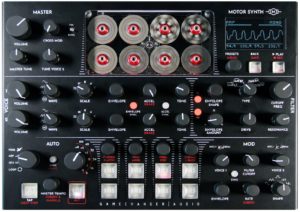
Gamechanger | Audio unveils revolutionary electro-mechanical Motor Synth at SUPERBOOTH19
RIGA, LATVIA: having presented an initial proof-of-concept prototype product at The 2019 NAMM Show in Southern California, January 24-27, uncharted music electronics territories explorer Gamechanger | Audio is proud to unveil the revolutionary Motor Synth — a digitally-controlled analogue electro-mechanical synthesizer that uses a system of electromotors (to convert electrical energy into mechanical energy) as its main sound source — in its finished desktop design at SUPERBOOTH19 in Berlin, May 9-11…
Motor Synth really represents a new method of analogue audio signal synthesis since digitally-controlled electromotors have never been used as the principal sound source for a commercial musical instrument — indeed, nothing like it has ever been built before! But actions always speak louder than words. So how, exactly, does the revolutionary Motor Synth work?
Well, simply speaking, Motor Synth produces sounds by accelerating and decelerating eight electromotors to precise rpm (revolutions per minute) that correspond with specific musical notes. Needless to say, the instrument in question’s eight-electromotor configuration means that it is a four- note true polyphonic synth with two voices per key played.
Digging deeper, Motor Synth takes a two-pronged approach to producing its core sound, starting with magnetic pickups placed on each of its eight electromotors; those electromotors’ spinning coils result in a very industrial-sounding, ridiculously over-the-top analogue tone — think eight harmonious revving engines pumping out an intimidating noise! Next, specially-designed reflective optical disks have been attached to the shafts of each electromotor. Each disk contains a graphical representation of some standard audio wave-shapes. As the electromotors spin, the disks are set into circular motion, and each wave-shape is read by a dedicated set of UV (ultraviolet) sensors, then converted into an audio signal. So the wave-shapes on the reflective optical disks become precise musical notes, corresponding to the speed of the electromotors.
Elsewhere, Motor Synth still features familiar analogue audio processing circuits — filters, envelopes, et al — alongside arpeggiation, cross- modulation sequencing, and multiple polyphonic mode facilities, as well as an innovative looping system that allows adventurous users to layer rhythm and melodies, just like when using a loop station.
Manifestly, Motor Synth is a desktop design — unlike its initial proof-of-concept prototype predecessor, but it can still be played out of the box via eight built-in control keys and four floating tuning pots. Performers and composers can, of course, connect any standard MIDI (Musical Instrument Digital Interface) controller, like a keyboard or DAW (Digital Audio Workstation), while Motor Synth is also capable of tracking a monophonic audio signal, such as guitar or bass, via its 1/4-inch mono input. Interestingly, Motor Synth can be configured to act as a harmonizer for electric guitars or other melodic instruments, recognising the pitch of a musical tone and instantly generating a complimentary tone by operating an electromotor at a matching frequency. Furthermore, users can create intervals and chords based on the frequency of the incoming signal with no need (necessarily) for a MIDI controller or inputting preprogrammed musical information.
Whatever way anyone chooses to play Motor Synth, a stunning visual experience is guaranteed. Get this: Motor Synth’s see-through protective glass cover above its core sound system of eight electromotors enables users to receive visual feedback from the instrument itself by being able to see those spinning electromotors in action. But better still, the visual experience is enhanced still further by the also-visible set of reflective optical disks attached to the electromotors’ shafts being coupled to a set of eight mini strobe lights, so those spinning disks themselves turn into a hypnotic light show, courtesy of the strobe effect!
As an instrument that uses electromotors as its main sound source, Motor Synth inherently possesses many unique sound traits that will surely appeal to many musicians that favour analogue electronic instruments and synthesizers in particular. Put it this way: with its unusual tonal and timbral qualities, unlimited microtonal pitch adjustment and modulation abilities, and note attack and decay properties influenced by the acceleration and deceleration curves of electromotors, Motor Synth works well across a wide range of musical styles.
Showcasing its third revolutionary product, Gamechanger | Audio will be proudly unveiling Motor Synth on booth (H320) at SUPERBOOTH19 — Europe’s first and largest trade fair for electronic musical instruments — in Berlin, May 9-11. Thereafter, it will be following in the super-successful crowdfunding footsteps of Gamechanger | Audio’s PLASMA Pedal, perfectly realising a revolutionary approach within the realm of overdrive and distortion by transforming the connected instrument’s live signal into a series of continuous high-voltage discharges within a xenon-filled tube, thanks to achieving 921% funding on Indiegogo in April 2018 (https://www.indiegogo.com/projects/plasma-pedal-high-voltage-distortion-unit–3#/). No doubt the equally- revolutionary electro-mechanical Motor Synth will follow suit, successfully realising a new method of analogue audio signal synthesis.
Explore and support the Indiegogo campaign for Gamechanger | Audio’s Motor Synth project here:https://www.indiegogo.com/projects/motor-synth/coming_soon
Watch Gamechanger | Audio’s automotive-assisted video for Motor Synth here: https://youtu.be/AaIhBu4adZ8
For more in-depth info, please visit the dedicated Motor Synth webpage here: https://www.gamechangeraudio.com/motor-synth/


